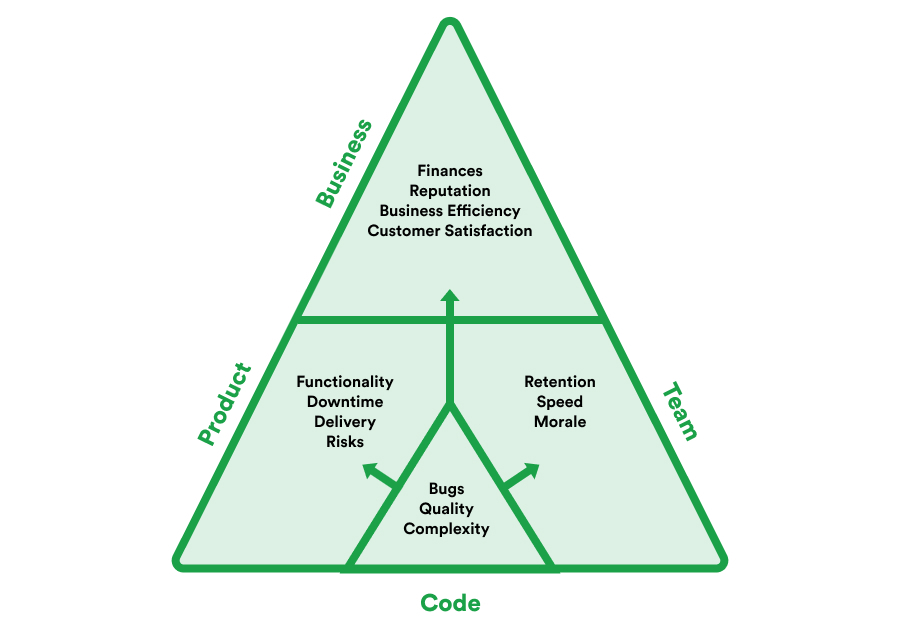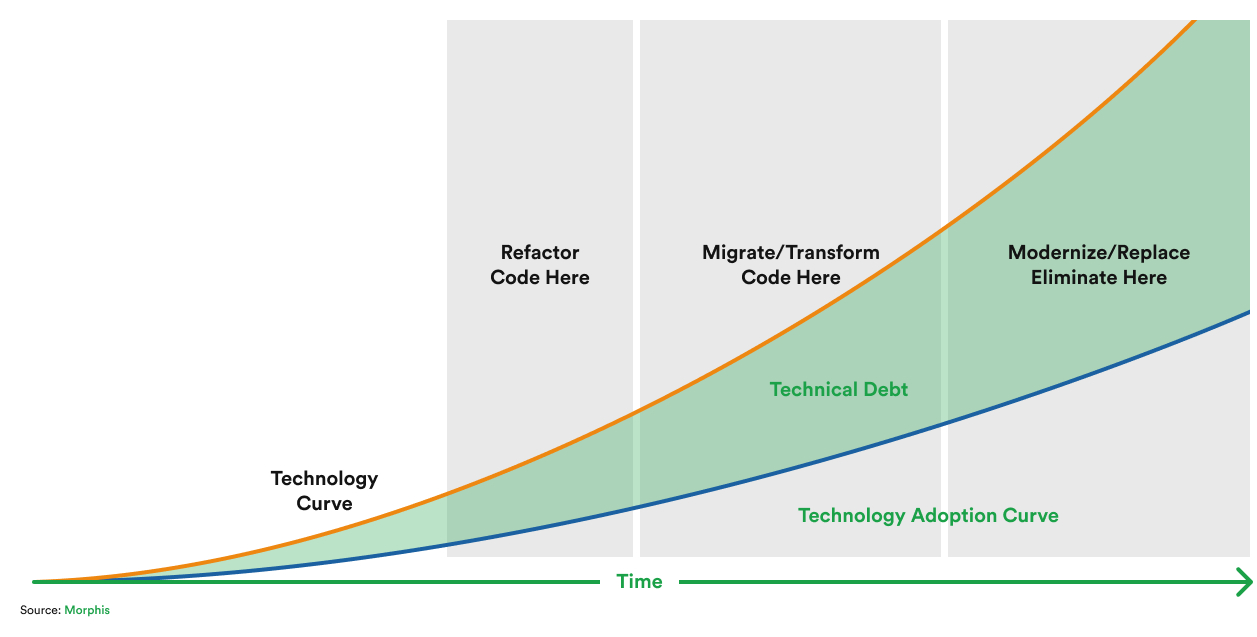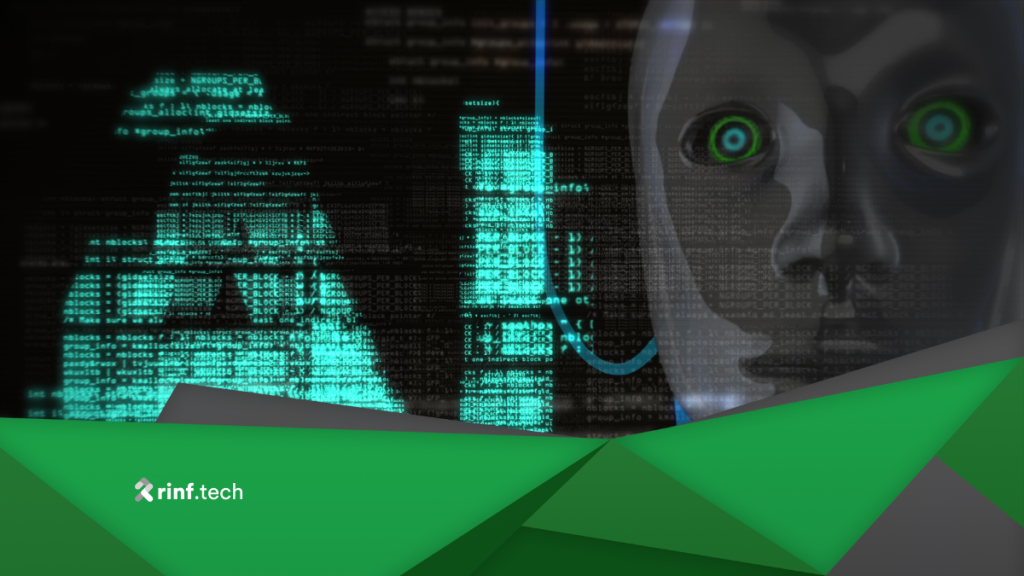
How to Roll Out an Innovation Project Within Your Company: Tips and Best Practices
This article will share three strategies to help R&D teams effectively and successfully implement new technologies.
The hidden nature of technical debt leads to a common misconception among business leaders that tech debt is a secondary concern that can be addressed later as it does not immediately impact operations or profitability. This misunderstanding can be risky, as the compounding interest of tech debt, in the form of increased maintenance costs, security vulnerabilities, and missed opportunities, can suppress a company’s agility and innovation. Recognizing and quantifying the hidden costs associated with technical debt is crucial for informed decision-making. It allows businesses to prioritize resources effectively and ensures that technology is an enabler of success rather than a barrier.
This article focuses on the often-overlooked aspects of tech debt, offering insights into its cost and the undeniable ROI of technology modernization. By carefully examining the impacts of technical debt and the benefits of addressing it proactively, companies can be prepared to make strategic decisions that align with their long-term vision and growth objectives.
Technical debt, a term often whispered in the halls of software development teams, carries hidden costs that extend far beyond the immediate compromises made for rapid deployment. At its core, technical debt includes the long-term burden organizations bear when short-term solutions, prioritizing speed over perfection, are chosen. This debt, however, is not just a matter of delayed coding practices but translates into tangible financial, operational, and strategic costs that can quietly undermine an organization’s efficiency and growth potential.
At first, maintenance costs skyrocket as legacy systems and patchwork fixes demand an increasingly larger share of IT budgets. These systems, while functional, become complex mazes of code that are costly to maintain and even costlier to update or replace. The labor-intensive nature of maintaining outdated systems drains financial resources and diverts attention away from innovation and the development of new capabilities.
Security vulnerabilities present another significant hidden cost. Often running on unsupported platforms, older systems are targets for cyber threats. The cost of addressing security breaches and ensuring compliance with evolving regulations can quickly escalate, not to mention the reputational damage and potential legal repercussions of data breaches.
Reduced agility is one of the more subtle costs of tech debt. In today’s fast-paced market, shifting and adapting to changing consumer demands is essential. However, organizations burdened with significant tech debt need help rolling out new features or updates swiftly, placing them at a competitive disadvantage. The lost opportunities due to this sluggishness can be the difference between leading the market and struggling to catch up.
The hidden costs of tech debt also extend to lost opportunities. Every moment spent patching up old systems is not paid to create value through new projects or innovations. The indirect cost of such missed opportunities can impede the direct costs of maintaining legacy systems, stifling long-term growth and the ability to capitalize on new market trends.
To quantify these hidden costs, organizations must consider the direct expenses associated with maintaining outdated technology and the broader implications on their ability to compete and innovate. For example, the price per bug fix in legacy systems can be significantly higher than in modern, well-maintained systems, and the downtime cost due to system failures can lead to lost revenue and diminished customer trust. Moreover, the inefficiencies baked into old technology can inhibit productivity, leading to an incremental effect on the bottom line far greater than the sum of its parts.

The Impact of Tech Debt
Technology modernization’s Return on Investment (ROI) is a vital metric for companies navigating the digital transformation landscape effectively. This ROI transcends cost savings, presenting more comprehensive benefits fueling long-term growth, competitiveness, and innovation. In evaluating technology investments, understanding the ROI involves comparing the upfront costs of modernizing systems against the multifaceted benefits these investments bring over time.
Modernization efforts, such as migrating to cloud-based solutions, adopting microservices architectures, or integrating cutting-edge technologies, yield far-reaching advantages. These include increased agility, enabling businesses to adapt to market changes and consumer demands rapidly. Enhanced scalability ensures that growing data volumes and user bases are managed efficiently without sacrificing performance. Improved security features protect against evolving cyber threats, safeguard critical data, and maintain customer trust. Moreover, modernization fosters innovation by providing a flexible and dynamic environment for deploying new services and features, thus opening new revenue streams and improving customer experiences.
Quantifying the ROI of these initiatives involves a holistic analysis of direct and indirect costs and benefits. Immediate benefits include reduced operational costs due to more efficient processes and lower maintenance requirements for modern systems. Though harder to quantify, indirect benefits include improved employee satisfaction using up-to-date and efficient tools, leading to higher productivity, and reduced turnover rates.
Companies that have migrated legacy applications to the cloud often report significant cost savings from reduced infrastructure and operational expenses and revenue growth from enhanced service offerings and market agility. An example comes to mind here: that of a fintech company that rinf.tech helped modernize their banking legacy system. With our help, they achieved a 6-digit yearly cost saving by discontinuing expensive Tibco license renewals, automating processes, and upgrading legacy systems, which is a testament to the tangible benefits of strategic modernization efforts.

Technology Adoption Curve
While full of substantial rewards, the journey towards technology modernization is always accompanied by challenges that can discourage even the most determined organizations. These obstacles range from budgetary constraints and organizational resistance to the complexities of change management and the ever-present skills gap. Yet, the strategic importance of modernization in today’s digital economy requires that these challenges be met with innovative and pragmatic solutions.
Budget constraints often emerge as the first limitation, with the initial outlay for modernization projects appearing impossible. However, a subtle understanding of modernization’s long-term ROI can help reframe these costs as investments rather than expenses. Adopting a phased approach to modernization allows for the spreading out of costs over time while enabling the organization to demonstrate early wins and build momentum for the project. This strategy can also alleviate fears and resistance within the organization by minimizing disruptions and allowing for gradual adjustment to new technologies and processes.
Change management is another critical challenge, as modernization initiatives necessitate significant organizational culture, processes, and operations shifts. Effective communication is vital, highlighting the benefits of modernization for the organization and individual employees. Engaging stakeholders from all levels of the organization in the planning and implementation phases can foster a sense of ownership and ease the transition. Additionally, providing comprehensive training and support helps reduce the skills gap, ensuring employees can effectively leverage new technologies.
Moreover, leveraging external expertise and partnerships can be invaluable in overcoming modernization challenges. Collaborating with technology partners like rinf.tech can provide access to specialized skills, experience, and insights, enabling organizations to navigate the complexities of modernization more effectively. A partner can offer tailored strategies, from cost optimization, including cloud adoption, to designing training programs that address specific organizational needs.
The need for technology modernization has never been more critical in the evolving digital landscape. As organizations wrestle with legacy systems’ challenges, including diminished efficiency, escalated security risks, and impeded innovation, the journey toward modernization represents a strategic investment in future readiness.
It is crucial for companies to not only recognize the pressing need to address their technological debt but also to act decisively in embarking on modernization projects. Adopting a proactive perspective toward technology management and employing a data-driven approach to decision-making cannot be overstated. Businesses are encouraged to consider the actual cost of their tech debt and to pursue modernization not as an optional endeavor but as a strategic imperative.
The landscape of technology modernization is rich and varied, containing a range of strategies tailored to each organization’s unique needs and objectives. Among these, cloud migration and the adoption of microservices architecture stand out for their transformative potential and substantial return on investment.
Cloud migration, for instance, offers unparalleled scalability, resilience, and cost-efficiency, allowing businesses to pay only for the resources they use while benefiting from the latest security and technology advancements. The agility afforded by cloud environments means that companies can rapidly deploy new features, scale operations to meet demand and enhance their disaster recovery capabilities, all of which contribute to a strong ROI by reducing operational costs and increasing revenue potential.
However, Microservices architecture enables organizations to decompose large, rigid applications into smaller, independently deployable services. This approach facilitates more accessible updates and maintenance and allows for more robust scalability and a faster time-to-market for new features. By adopting microservices, businesses can achieve greater agility, improved resilience, and a more efficient use of resources, leading to cost savings and enhanced competitive advantage. When aligned with an organization’s strategic goals, the specificity of these modernization approaches can significantly amplify their ROI, making a compelling case for their adoption.
Companies must first understand their existing tech debt and its implications to navigate the complex journey of technology modernization effectively. This requires a comprehensive assessment beyond surface-level symptoms to identify the root causes of inefficiencies, security vulnerabilities, and operational bottlenecks. Utilizing a framework or tool that quantitatively and qualitatively evaluates tech debt can provide organizations with actionable insights into the area’s most needing modernization.
Once the landscape of tech debt is understood, calculating the potential ROI of modernization initiatives becomes crucial. This involves accounting for the direct costs associated with legacy systems, such as maintenance and downtime, and considering the opportunity costs of missed innovation and market responsiveness. By comparing these costs against the projected benefits of modernization, such as increased efficiency, revenue growth, and risk mitigation, companies can make informed decisions about where and how to invest in technology upgrades.
Tools and frameworks that facilitate this analysis can be invaluable, enabling organizations to prioritize initiatives based on their potential to drive value. Here are some relevant industry examples.

This article will share three strategies to help R&D teams effectively and successfully implement new technologies.

This article explores interesting machine learning projects that companies in various sectors can launch to gain a significant competitive advantage in a highly saturated business landscape.

This article explores top use cases of integrating ChatGPT into business strategies and operations across multiple industries and domains.
Copyright © 2023 rinf.tech. All Rights Reserved.
Terms & Conditions. Cookie Policy. Privacy Policy.
Politica Avertizari de Integritate (RO)